Kanban has long ago left the automotive industry and conquered the IT world, but now, with an increased focus on flow, it is about to expand its reach to the entire business. Many business leaders have realized that Kanban has an extremely flexible architecture that allows it to scale across the enterprise naturally and gently. More and more companies embrace Kanban's "start with what you do now" principle and are on their way to true business agility. But how do you go about that exactly?
While the details of each Kanban implementation vary from organization to organization and from the largest groups down to the smallest companies, the heart of Kanban is the same: defining, managing, and improving services inside an organization that delivers knowledge work.
Why Scale Is Important?
Let's start with the bigger picture and answer the question "why bother" in the first place.
Nowadays, the business environment is more turbulent than ever. Trends come and go fast, market conditions change, and new products emerge every year. Furthermore, the rise of technology and digital transformations has allowed start-ups to innovate and disrupt the status quo quickly.
Unless businesses can respond to these frequent changes on time, they risk losing their competitiveness on the market. That's why to achieve a state of true organizational survivability, the need for scaling Lean/Agile practices is essential.
In fact, when first embarking on a transformational journey, managers often train their teams on Lean or Agile but only see local improvements. That's because they miss an integral piece of the puzzle - the interaction between organizational structures. To back this up, a very useful quote by Dr. Russel Ackoff comes to mind:
"A system is never the sum of its parts". It's the product of the interaction of its parts"
This emphasizes the importance of systems thinking and optimizing the whole rather than focusing on local flaws. When implementing this approach, it's important to start small, assess your own environment, and then apply the things that can work for your situation instead of copying what somebody else did. We believe that Kanban is the perfect illustrator of this mentality.
What Is Kanban at Scale?
In its core, Kanban focuses on evolution rather than revolution. You simply start where you are now without disrupting any of your existing processes or roles. Then, you look to continuously improve and tailor the Kanban implementation to your own case. After all, achieving organizational agility is not a one-time endeavor but a long-term process that should evolve based on the needs of the business environment.
Here we should mention that a lot of people believe that Kanban's principles and practices are predominantly useful on the team level for improving process efficiency. While that is true, there is no book or a guide to Kanban which suggests that the method is applicable only for teams.
In fact, you can visualize work, limit WIP, manage flow, make policies explicit, implement feedback loops, and improve collaboratively across all levels of the organization, regardless of their complexity.
So, scaling Kanban means applying those practices across multiple layers in the company and connecting them together in order to achieve flow. You also need to recognize that your organization is a network of interdependent services and then identify value streams that you should look to optimize continuously.
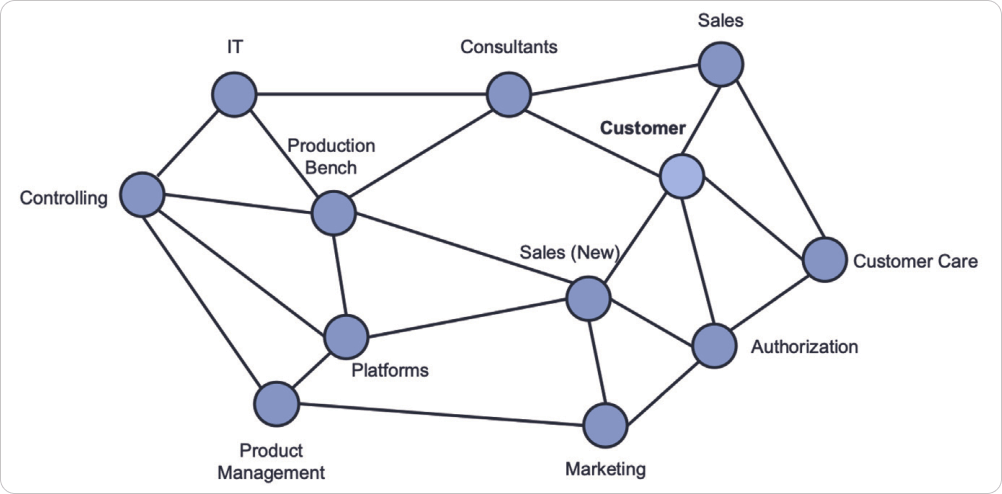 Image credit: Kanban Maturity Model (KMM), Second Edition
Image credit: Kanban Maturity Model (KMM), Second Edition
The practical approach shows that bringing Kanban at scale usually happens on three levels: team, operational, and strategic. You can use interconnected Kanban boards to tie this structure together and visualize the progress of small work items, larger projects, and company-wide strategic initiatives.
As a result, you will be able to build a complete management system within your organization that enables you to deliver the right things at the right time and thus satisfy your customers.
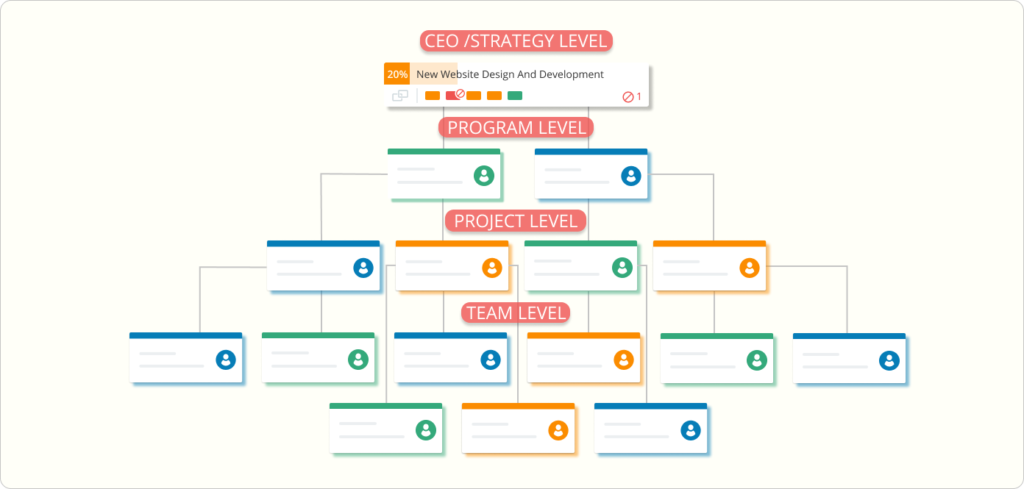 Kanban management system connecting strategy, program, project, and team levels within an organization
Kanban management system connecting strategy, program, project, and team levels within an organization
What Are the 3 Key Scaling Kanban Principles?
When looking to bring Kanban at scale, 3 main principles should act as your stepping stone to building a more resilient and responsive organization.
They are the following:
- Scale-up in a service-oriented fashion one service at a time.
- Design each system using the systems thinking approach to implementing Kanban (STATIK).
- Use the Kanban cadences as the management infrastructure to create balance and alignment.
Let's go over each one of these principles and look at their practical application.
1. Scaling One Service at a Time
As mentioned above, your organization is an ecosystem of interdependent services. From product management and IT to marketing and sales, every part of the organization develops a service that provides value to the end customer. This happens either directly or indirectly as some services are complementary to delivering the final, fit-for-purpose solution (ex. support, consultants, etc.).
That's why every service in the organizational structure is dependent on another one from the ecosystem. There are also shared services that are executed by two or more teams as well as sub-services that specific team members might be responsible for.
Whatever the structure is, the main idea is that you start scaling Kanban by first identifying services inside the organization. To do that in practice, a useful technique from the Lean world that you can include in your arsenal is value stream mapping. Coupled with Kanban boards, you can use it to see at a glance the different steps that your company or separate parts of it go through in order to create value for the end customer.
 Visualization of upstream and downstream value streams in a Kanban system
Visualization of upstream and downstream value streams in a Kanban system
Based on that information, you should look to visualize your work and then gradually build a Kanban system for every service or value stream in the organization, one at a time.
2. Design Each Kanban System with STATIK
STATIK, in a nutshell, represents a systems thinking approach to introducing Kanban. It is a collection of steps that are iterative and not necessarily sequential, as learnings from each one of them are incorporated in the next. Remember, Kanban is an evolutionary approach that builds on previous steps and there isn't a single best practice to apply it.
The main idea here is to design a Kanban system for every service in the organization and then connect all of them together to achieve flow. The practical approach for that is through the use of related Kanban boards where you should look to apply Kanban's main practices including their variations. A great source that you can use for guidance here is the Kanban Maturity Model.
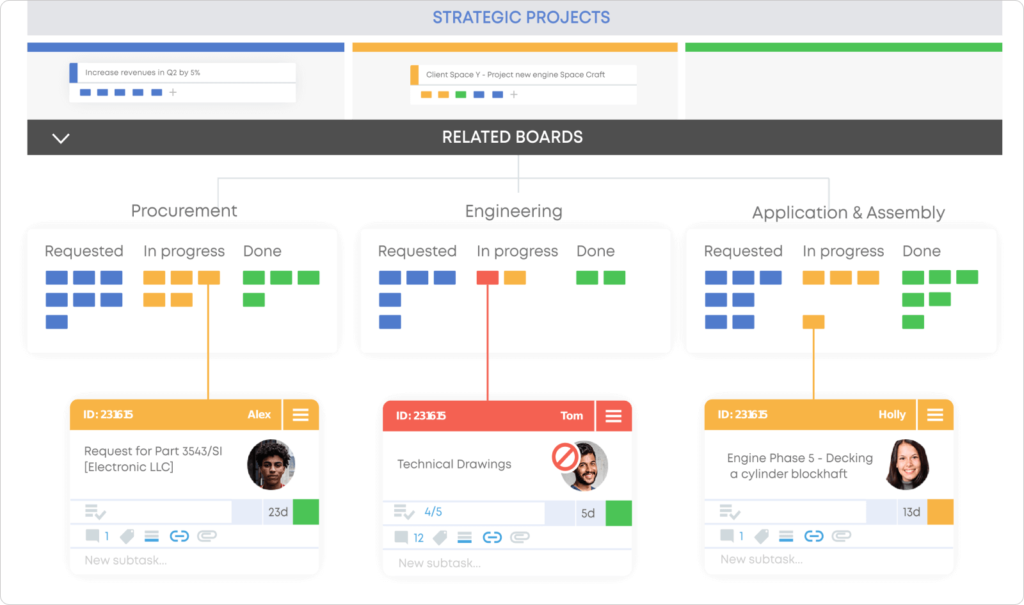 Visualization of interconnected Kanban system
Visualization of interconnected Kanban system
So, without further ado, let's take a look at the steps of STATIK. For every service in the organization you should:
- Understand what makes the service fit for the purpose of the customer
- Understand sources of dissatisfaction with the current system
- Analyze demand
- Analyze capability
- Model workflow
- Discover classes of service
- Design the Kanban system
- Socialize the design and negotiate expectation
Explaining these steps in detail is way beyond the scope of this article. That's why I will briefly walk you through them so you have an idea of what they are all about.
1. What Makes the Service Fit-for-Purpose?
Answering this question is critical because everything that is done in an Agile environment should be seen from the perspective of the customer. So, here, you should explore criteria that define customer satisfaction.
Those are usually related to delivery rates and quality of service and determine how the customer evaluates whether the service is acceptable. Having said that, your first step to building a Kanban system should be to identify these criteria and continuously evolve the service in order to make it "fit-for-purpose".
2. Understanding Sources of Dissatisfaction
Those can be both internal and external. For example, a customer might complain of unpredictability, while team members complain of being overburdened with too much work.
Finding these sources of dissatisfaction will provide an important input to the design of the Kanban system for a service. Knowing exactly where the problem lies will help you focus your attention on practices such as tightening up WIP limits, for example, to better match demand with capabilities.
3. Analyze Demand
Speaking about demand, to build an effective Kanban system you need to analyze the arrival rate of your tasks. How often do you get requests from other services? What work types do you receive? What is the demand for each one of them?
The answers to these questions will give you insights on how to allocate capacity in your Kanban system so you can better structure it to manage the flow of various types of work.
4. Analyze Capability
Matching demand with capabilities is an essential but often neglected step when designing a Kanban system. You need to look past historical data for service delivery and understand the current capability compared to customer expectations.
In the Kanban world, a common tool that can be used for capability analysis is the Cumulative Flow Diagram. When running some initial tasks through your Kanban board, you can use the diagram to analyze the current rate of arrivals and departures in your process. As a result, you will be better equipped with the knowledge to tighten up WIP limits, for example, and design your Kanban system after the real state of your team's capability levels.
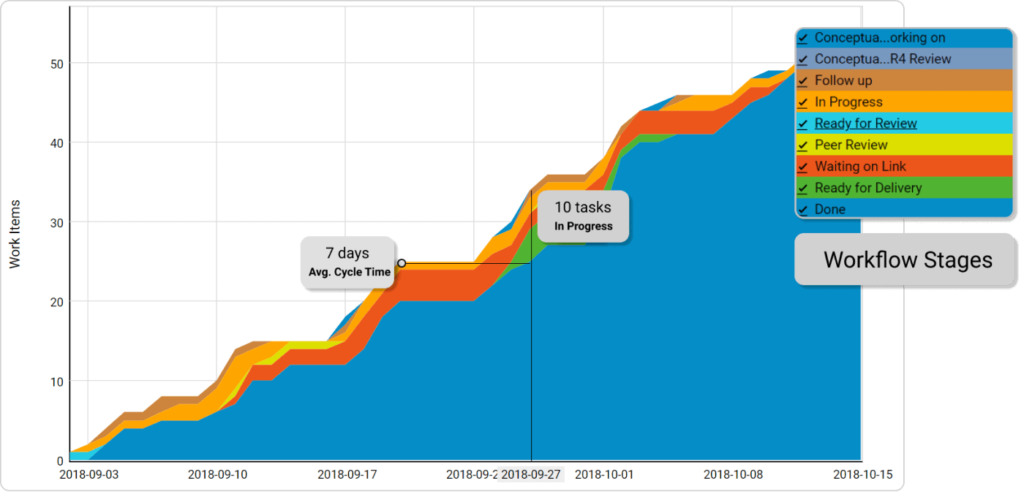
Cumulative flow diagram
5. Model Workflow
This step is about modeling your workflow on a Kanban board after the requirements of your customers or dependent services. The idea here is to map the sequence of dominant activities that are used to discover more details for the final deliverable.
Bear in mind that this is an iterative process. You should collect data, speak to customers or other services, and tweak the workflow based on the best way you generate value for them.
6. Discover Classes of Service
This is one of the most important parts of building an efficient service delivery system. In a knowledge work set-up, tasks are diverse which means that they will be different types but also have different urgency.
Discovering Kanban classes of service (such as Expedite, Fixed Delivery Date, etc.) will help you define your workflow to make better sequencing decisions (based on cost of delay) so you can satisfy your customer's expectations. In practice, once you've defined classes of service in your workflow, you can use Kanban swimlanes to visualize them in your process.
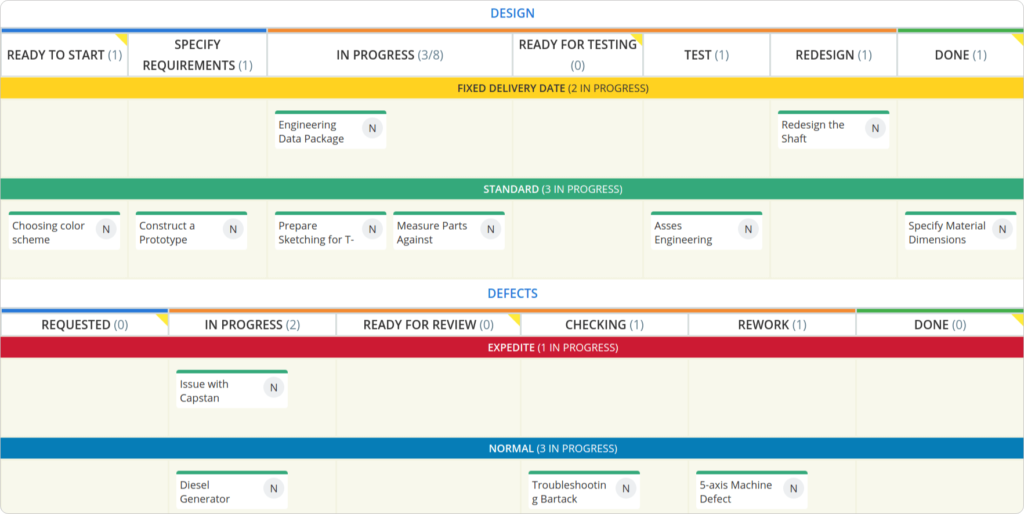 Visualization of Kanban classes of service using swimlanes on a Kanban board in Kanbanize by Businessmap
Visualization of Kanban classes of service using swimlanes on a Kanban board in Kanbanize by Businessmap
7. Design the Kanban System
Once you have input from the previous steps, you can begin to design a real Kanban system that reflects the needs of your customers as well as the true capabilities of your team members. Here it is important to track flow metrics on a regular basis so you can make data-driven decisions for continuous improvement.
8. Socialize the Design and Negotiate the Implementation
This step emphasizes the importance to get buy-in and feedback from other relevant parties in the organization on the design of your Kanban system. While it's not realistic to include every single stakeholder, a good practice is to hold workshops with teams from dependent services to sync the work processes of multiple Kanban systems.
3. Implement the Kanban Cadences as the Management Infrastructure
The last principle for scaling Kanban is about creating information flow and eventually enabling symbiosis across the entire organizational structure. This is done with the help of regular cadences or feedback loops. Essentially, they represent meetings that are applied across all levels in the company where team members and managers align business processes and continuously look for improvements.
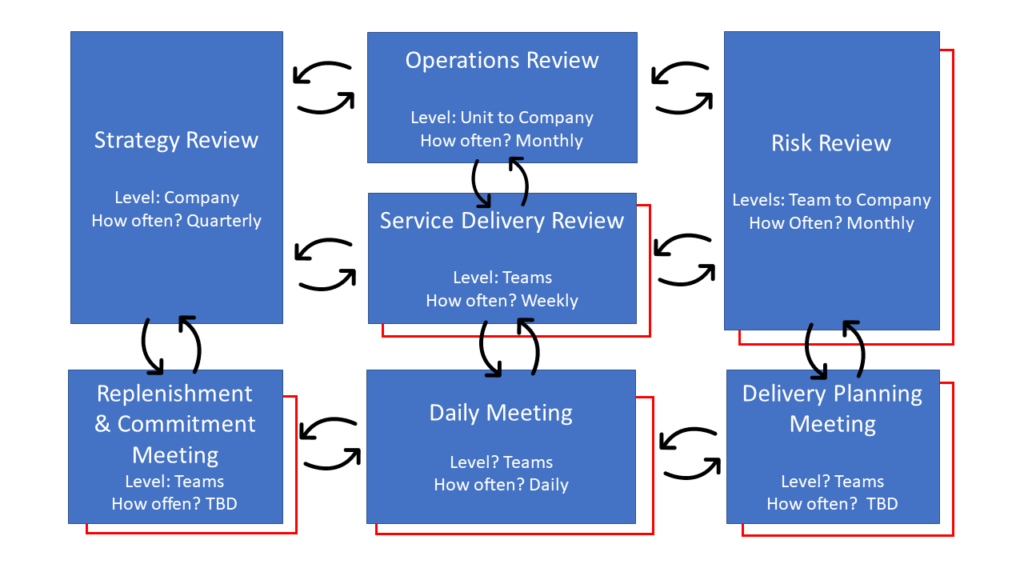
Kanban feedback loops
The important thing to remember about the Kanban cadences is that they are divided into two major categories - Service Delivery (Daily Meeting, Replenishment, Delivery Planning) and Evolutionary sets (Service Delivery Review, Operations Review, etc.).
In the former, teams predominantly sync and plan their service delivery processes on small batches while the latter serve as learning cycles. When bringing Kanban at scale, the Evolutionary set of meetings should go from the team level all the way up to the company's strategy. The idea here is every learning cycle to collect data of work processes and feed the one above it in order to create alignment between services and make data-driven decisions.
As we mentioned at the beginning of this article, a complete management system is only possible when there is an interaction between all of its parts. This is where the Kanban cadences fill the missing piece of the puzzle. They enable organizations to achieve balance and agility which ultimately leads to better enterprise service delivery.
Scaling Kanban In a Nutshell
At the end of the day, you should be aware that when scaling Kanban, there isn't a single best way to do it. Still, the principles above serve as a great guide to eventually enabling organizational and operational agility.
Of course, what we have discussed in this article is barely scratching the ground of what you will need for a successful Kanban implementation across the whole company.
For that, we recommend professional training and then following through the Kanban Maturity Model. However, the principles for bringing Kanban at scale remain the same - start with what you do now and continuously evolve from there.

Nikolay Tsonev
Product Marketing | PMI Agile | SAFe Agilist certified
Nick is a seasoned product marketer and subject matter expert at Businessmap, specializing in OKRs, strategy execution, and Lean management. Passionate about continuous improvement, he has authored numerous resources on modern-day management. As a certified PMI practitioner and SAFe Agilist, Nick frequently shares his insights at Lean/Agile conferences and management forums.



